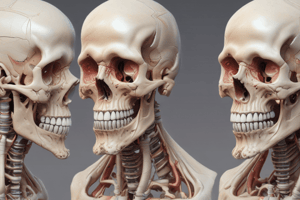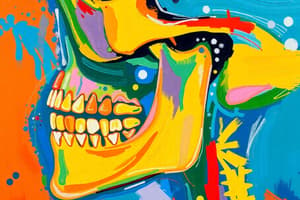Podcast
Questions and Answers
Which movement of the mandible is responsible for opening the mouth?
Which movement of the mandible is responsible for opening the mouth?
- Protrusion
- Depression (correct)
- Retrusion
- Elevation
During rotational movement of the mandible, what is the relationship between the mandibular condyle and the disc?
During rotational movement of the mandible, what is the relationship between the mandibular condyle and the disc?
- The disc moves in the direction of the rotating condyle (correct)
- The condyle and disc rotate together
- The condyle slides relative to the disc
- The condyle and disc move in opposite directions
What is the primary function of elevation of the mandible?
What is the primary function of elevation of the mandible?
- To facilitate speech
- To close the mouth
- To open the mouth
- To grind food during mastication (correct)
What is the effect of abnormal function in one TMJ on the other?
What is the effect of abnormal function in one TMJ on the other?
During lateral excursion, what is the movement of the condyle and disc?
During lateral excursion, what is the movement of the condyle and disc?
What is the direction of movement of the mandibular condyle and disc during protrusion?
What is the direction of movement of the mandibular condyle and disc during protrusion?
What occurs during the early phase of opening the mouth?
What occurs during the early phase of opening the mouth?
What is the function of the articular disc in the TMJ?
What is the function of the articular disc in the TMJ?
During left lateral excursion, what is the movement of the left condyle?
During left lateral excursion, what is the movement of the left condyle?
What marks the transition from the early phase to the late phase of opening the mouth?
What marks the transition from the early phase to the late phase of opening the mouth?
What is the primary function of the articular disk of the TMJ?
What is the primary function of the articular disk of the TMJ?
What type of joint is the TMJ?
What type of joint is the TMJ?
What is the main function of the lateral temporomandibular ligament?
What is the main function of the lateral temporomandibular ligament?
What is the anatomical structure that separates the TMJ into two synovial joint cavities?
What is the anatomical structure that separates the TMJ into two synovial joint cavities?
What is the movement that involves the anterior movement of the mandible without significant rotation?
What is the movement that involves the anterior movement of the mandible without significant rotation?
What is the function of the retrodiscal tissue in the TMJ?
What is the function of the retrodiscal tissue in the TMJ?
What is the shape of the mandibular condyle?
What is the shape of the mandibular condyle?
What is the function of the fibrous capsule in the TMJ?
What is the function of the fibrous capsule in the TMJ?
What is the function of the muscles in the TMJ?
What is the function of the muscles in the TMJ?
What is the opposite movement of protrusion?
What is the opposite movement of protrusion?
During translation, what is the direction of the condyle and disc movement?
During translation, what is the direction of the condyle and disc movement?
What happens to the axis of rotation at the end of opening?
What happens to the axis of rotation at the end of opening?
What is the result of bilateral contraction of the masseter muscle?
What is the result of bilateral contraction of the masseter muscle?
What is the result of unilateral contraction of the temporalis muscle?
What is the result of unilateral contraction of the temporalis muscle?
What is the result of bilateral contraction of the medial pterygoid muscle?
What is the result of bilateral contraction of the medial pterygoid muscle?
What is the result of unilateral contraction of the medial pterygoid muscle?
What is the result of unilateral contraction of the medial pterygoid muscle?
What is the function of the lateral pterygoid muscle?
What is the function of the lateral pterygoid muscle?
What is the special role of the superior head of the lateral pterygoid?
What is the special role of the superior head of the lateral pterygoid?
What is the main function of the secondary muscles of mastication?
What is the main function of the secondary muscles of mastication?
What is the result of bilateral contraction of the lateral pterygoid muscle?
What is the result of bilateral contraction of the lateral pterygoid muscle?
Flashcards are hidden until you start studying
Study Notes
TMJ Biomechanics: Function
- TMJ performs bilateral actions, including mastication, talking, and swallowing
- The joint works with the tongue and teeth during the mastication process
TMJ Biomechanics: Anatomy
- The TMJ is a bicondylar synovial joint between the condyle in the lower jaw and the mandibular fossa of the temporal bone
- The joint has a wide range of rotation and translation, with an articular disk cushioning the forces related to mastication
- The disk separates the joint into two synovial joint cavities: the inferior joint cavity and the larger superior joint cavity
Mandibular Condyle
- The condyle has a convex shape with short medial and lateral poles
- The medial pole is more prominent than the lateral pole
- The condyle is covered by a thin layer of fibrocartilage
Mandibular Fossa
- The fossa is part of the temporal bone and forms the joint with the condyle
Articular Disk of the TMJ
- The disk is made of dense fibrocartilage
- It lacks blood supply and sensory innervation
- The disk's main function is to generate greater congruency and reduce contact pressure
Stability of the TMJ
- Passive stability is provided by the fibrous capsule, articular disk, lateral temporomandibular ligament, and retrodiscal tissue
- Active stability is provided by muscles
Osteokinematics of the TMJ
- The TMJ has four movements: protrusion, retrusion, lateral excursion, and depression-elevation
- Protrusion and retrusion involve anterior and posterior movements without significant rotation
- Lateral excursion involves side-to-side movement of the mandible, guided by the mandibular fossa and articular disk
- Depression and elevation involve opening and closing the mouth
TMJ Arthrokinematics
- The TMJ typically involves bilateral action
- During rotational movement, the mandibular condyle rolls relative to the inferior surface of the disk
- During translational movement, the mandibular condyle and disk slide together
- The disk usually moves in the direction of the translating condyle
Protrusion and Retrusion
- Protrusion involves the mandibular condyle and disk translating anteriorly and slightly downwards
- Retrusion involves the mandibular condyle and disk translating posteriorly and slightly upwards
Lateral Excursion
- Primary movement involves side-to-side translation of the condyle and disk within the fossa
- Secondary movement involves slight rotational components
Depression and Elevation
- The early phase of opening the mouth involves primary rotation of the mandible relative to the temporal
- The late phase involves a gradual transition from primary rotation to primary translation
- At the end of opening, the axis of rotation shifts inferiorly
Kinetics of the TMJ
- The masseter muscle elevates the mandible and brings teeth into contact
- The temporalis muscle elevates the mandible and slightly retrudes it
- The medial pterygoid muscle elevates the mandible and protrudes it
- The lateral pterygoid muscle depresses the mandible and protrudes it
- The superior head of the lateral pterygoid adjusts disc position
Studying That Suits You
Use AI to generate personalized quizzes and flashcards to suit your learning preferences.




